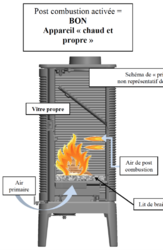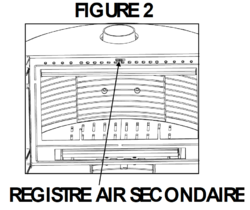I am using a French made wood stoves model Itaya
http://www.invicta.fr/en/wood-stoves/chimney-stoves/itaya-chimney-stove
Specs:
My question is: this wood burner is, according to the mentioned specifications Green (5 stars) and also is rated as Post-Combustion type. I thought it would imply an air intake from of the back of the burner which wood lead air to the top for the wood released gas and particles to be burned.
However there is no air intake from the back neither the usual device with many small holes that release the air to do the secondary combustion, inside.
This burner only has two air intakes: from the bottom close to the door (regulated) close to the ash tray and also close to the door up that the does airwash ventilation to keep the glass clear for a bit more.
I am attaching a file with the specifications, sorry it is in French, but there are schematics.
Could anybody explain me with this.
Many thanks for your time!!
http://www.invicta.fr/en/wood-stoves/chimney-stoves/itaya-chimney-stove
Specs:
- In compliance with : EN 13240 standard - BImSchV
- Reference : 6110-44
- Heat output : 12 kW
Efficiency : 76% - CO level : 0.1%
Flamme verte : 6 stars - Performance rate : 0,7
Post-combustion system - Continuous fire
Airwash system - Fuel : Log 25, Log 33, Log 50
Log length : 71 cm - Loading : Front loading
Flue diameter : 180 mm - Flue location : top, rear
Dimensions : H 846 x L 1051 x P 431 mm - Weight : 187 kg
Heating volume : 160 to 480 m3 - Heating surface : 64 to 192 m2
Design : Contemporary - Finishing : Anthracite
Warranty : 5 years
My question is: this wood burner is, according to the mentioned specifications Green (5 stars) and also is rated as Post-Combustion type. I thought it would imply an air intake from of the back of the burner which wood lead air to the top for the wood released gas and particles to be burned.
However there is no air intake from the back neither the usual device with many small holes that release the air to do the secondary combustion, inside.
This burner only has two air intakes: from the bottom close to the door (regulated) close to the ash tray and also close to the door up that the does airwash ventilation to keep the glass clear for a bit more.
I am attaching a file with the specifications, sorry it is in French, but there are schematics.
Could anybody explain me with this.
Many thanks for your time!!
Attachments
Last edited by a moderator:




 . Réglage d'allure is the primary air. 50% open for maximum heat and closed for overnight burn. On this stove the secondary air can also be adjusted but it is more a one time adjustment (REgistre d'air secondaire). You adjust it base on the draft and dont play with it anymore after. You control the stove using the primary air like any EPA stove afterward. Well at least this is what the manual says.
. Réglage d'allure is the primary air. 50% open for maximum heat and closed for overnight burn. On this stove the secondary air can also be adjusted but it is more a one time adjustment (REgistre d'air secondaire). You adjust it base on the draft and dont play with it anymore after. You control the stove using the primary air like any EPA stove afterward. Well at least this is what the manual says.